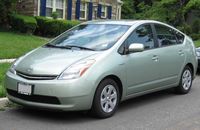Blog posts on long term thinkingPosts selected fromManagement Blog - Engineering Blog - Investing Blog and other blogs - Robots for Health Care from Toyota
Most often innovation efforts take the form of understanding the jobs your customers are using your products and service for now and developing new solutions to delight those customers. This is difficult for companies to pull of successfully.
Occasionally innovation involves meeting completely new needs of customers. For example Toyota started as a loom company and is now known as a car company. Making such a radical change is not often successful.
Will Toyota be able to add robots to the products it produces successfully? I believe they have a chance. But it won’t be easy. continue reading: Robots for Health Care from Toyota - Technological Innovation and Management
 Organizations need to be designed to be robust and to cope well with the increasingly rapid pace of transformative innovation. This again reinforces the importance of management improvement practices that I have been writing about here (on the Curious Cat Management Improvement blog) for more than 10 years. Organizations that do not delight customers, know the jobs to be done that their customers have, focus on the future (long term thinking), understand how to use data, have well designed processes that allow those at the gemba to know what to do and know how to rapidly adjust based on new realities and possibilities are at great risk. continue reading: Technological Innovation and Management - 10 stocks for 10 years
The 10 stocks I came up with are (closing price on 22 April 2005 – % of portofilo invested):
- Templeton Dragon Fund (TDF – 16.40 – 16%) – a closed end mutual fund investing in China, Hong Kong, Taiwan, Singapore… This one doesn’t fit the criteria but does a great job of filling out the portfolio in my opinion.
- Dell (DELL – 36.43 – 12%)
- Toyota (TM – 72.42 – 12%)
- Google (GOOG – 215.81 – 12%)
- Pfizer (PFE – 27.22 – 8%)
- Amazon (AMZN – 33.04 – 8%) They are only just starting to generate cash but I like their prospects.
...
["I should have picked Apple instead of Dell but even with that mistake the fund did very well - I did add Apple in 2010" John, Oct 2017] continue reading: 10 stocks for 10 years - Traffic Congestion and a Non-Solution
For decades traffic congestion has been a problem in American cities and one that has continued to get worse. The typical proposed solution is to increase the number of roads. The theory behind this solution is not normally stated but, I believe, it amounts to: “if we build more roads then the system will have more capacity which has to decrease congestion.” Unfortunately this theory fails to take into account the past data on the increasing capacity of roads “solution.”
...
Ackoff’s solution does require actually changing the system. That is not easy to accomplish. However, if the desire is to reduce congestion the solution is not likely to be to just keep doing what we have been doing (given that it isn’t working). Building more and more capacity doesn’t seem to achieve the desired results. continue reading: Traffic Congestion and a Non-Solution - Fast Company Interview: Jeff Immelt
My guess would be that what lead to this quote is not a lack of understanding that managers need the same qualities today they needed 10 years ago but the compulsion to feed the media frenzy for some incredible new insight. It just isn’t sexy to say “we need the same leadership qualities we needed in the past.” Deming stressed the importance of these “new” qualities he states more than 50 years ago and I think most decent managers have know you need to “know why we’re doing them”
...
Customer focus and innovation would also be at the top of the list of important issues and were 10 years ago and will be 20 years from now. What is important for management does not change much.
occasionally innovation is so dramatic it drastically changes the practice of management, two examples:
1) the use of information technology
2) the whole quality movement [Deming’s ideas, SPC, Toyota/Lean, Six Sigma… continue reading: Fast Company Interview: Jeff Immelt - W. Edwards Deming’s Seven Deadly Diseases
Seven Deadly Diseases
- Lack of constancy of purpose
- Emphasis on short term profits (Overreaction to short term variation is harmful to long term success. With such focus on relatively unimportant short term results focus on constancy of purpose is next to impossible.)
- Evaluation of performance, merit rating or annual review (see: Performance Without Appraisal: What to do Instead of Performance Appraisals by Peter Scholtes).
- Mobility of top management (too much turnover causes numerous problems)
- Managing by use of visible figures, with little of no consideration of figures that are unknown or unknowable.
continue reading: W. Edwards Deming’s Seven Deadly Diseases - Science and Engineering Macroeconomic Investment
 The United States has benefited tremendously from the decisions to fund the National Science Foundation (as well as other investments in science) for decades. Other countries have seen the wisdom in those investments and seem to be committing much more to those investments than the US lately. I think it is very wise of them and will serve the world well. But I fear the United States has already allowed itself to lose a great deal of the competitive advantage it built up in the middle of the last century.
In the last couple decades we have been able to coast on the lead we had. We could have many of the best minds come to our colleges and then keep them here once they graduated with advanced degrees. However, the lead we had is rapidly being eliminated. This does not mean the US will immediately be uncompetitive. But it will mean one of the great advantages we had will be greatly reduced.
The United States still has competitive advantages that will continue to serve us well in harnessing advanced technology for economic gain. But others have been making strategic decisions to gain some of those advantages for themselves. And the United States will almost certainly continue to see its scientific and engineering leadership in the world erode. And the economic consequences will be dramatic. continue reading: Science and Engineering Macroeconomic Investment - The Purpose of an Organization
W. Edwards Deming described the purpose of an organization in New Economics, on page 51, as:
The aim proposed here for any organization is for everybody to gain – stockholders, employees, suppliers, customers, community, the environment – over the long term. continue reading: The Purpose of an Organization - The Quick Fix
W. Edwards Deming
One trouble with American industry today is that top management supposes that one lecture or one day will do it. “Come, spend a day with us, and do for us what you did for Japan, that we too may be saved.”
continue reading: The Quick Fix - Toyota Engineers a New Plant: the Living Kind
Toyota’s vision:
First, making things that benefit both people and the world as a whole.
…
Second, as a member of society, we must fulfill our responsibilities to all stakeholders. We must provide to customers cleaner, safer, and more attractive products with excellent value. To shareholders, we must enhance share value through long-term and stable growth by increasing profits and paying appropriate dividends. With business partners, we must engage in fair business based on a spirit of mutual benefit.
To our employees, we must provide a workplace where they can work with pride based on mutual trust and responsibility between labor and management, and respect for people.
continue reading: Toyota Engineers a New Plant: the Living Kind - Marketing in a Lean Company
- Management Training Program
So I said to the Toyota executive, “You’ve only got two or three suppliers per category, and you never take bids. How do you know you aren’t being ripped off?” So this guy, who was around 60, gives me an incredibly frosty look and says, “Because I know everything.” Everything? “That’s my job,” he says.
Reading “Because I know everything” brings to mind an arrogant blowhard to many in America (I think). Probably because most who would say that, are arrogant blowhards. But when someone has worked (a Toyota executive or a baker) for 40+ years in the same area those words can have quite a different meaning than a 31 year old MBA working in his third industry. Managing with constancy of purpose and long term thinking can make a big difference. continue reading: Management Training Program - Innovate or "Play it Safe: to Avoid Risk
There are many reasons why avoiding risks is smart and should be encouraged. But when avoiding risks stifles innovation the risks to the organization are huge.
Playing it safe isn't always safe. In rapidly changing markets (which are quite common lately) "playing it safe" is often riskier than "taking chances" on new ideas. continue reading: Innovate or "Play it Safe: to Avoid Risk - The 70 Percent Solution
Google CEO Eric Schmidt:
We spend 70 percent of our time on core search and ads. We spend 20 percent on adjacent businesses, ones related to the core businesses in some interesting way. Examples of that would be Google News, Google Earth, and Google Local. And then 10 percent of our time should be on things that are truly new. An example there would be the Wi-Fi initiative.
continue reading: The 70 Percent Solution - Innovation at Toyota in Developing the Prius

By the end of 1993 the development team had determined that higher oil prices and a growing middle class around the world would require the new car to be both roomy and fuel-efficient. Other than that, they were given no guidance. “I was trying to come up with the future direction of the company,” says Watanabe, who headed corporate planning at the time. “I didn’t have a very specific idea about the vehicle.”
Investing in innovation is risky. If successful, the benefits can build a competitive advantage that is difficult for others to eliminate. However, others will try and if you fail to execute as well in the future those benefits can disappear quickly. Toyota shows few signs of letting others catch up though.
continue reading: Innovation at Toyota in Developing the Prius
|